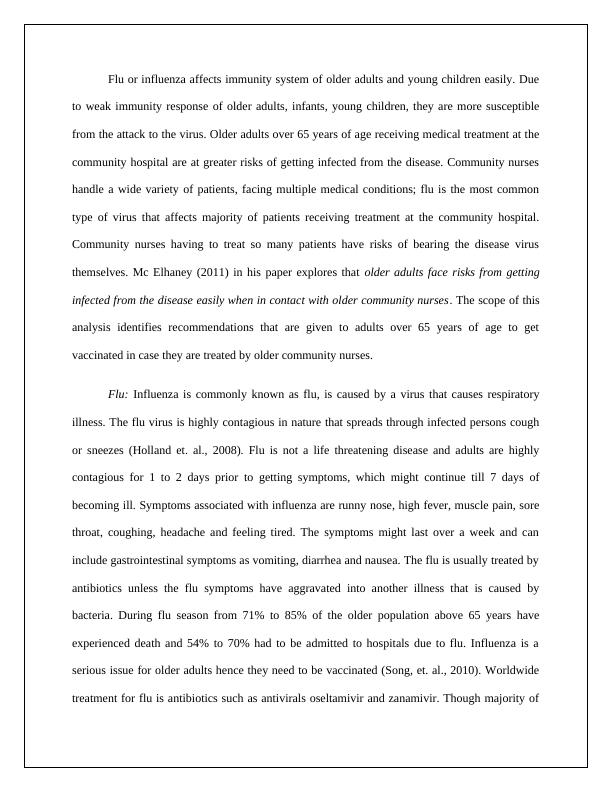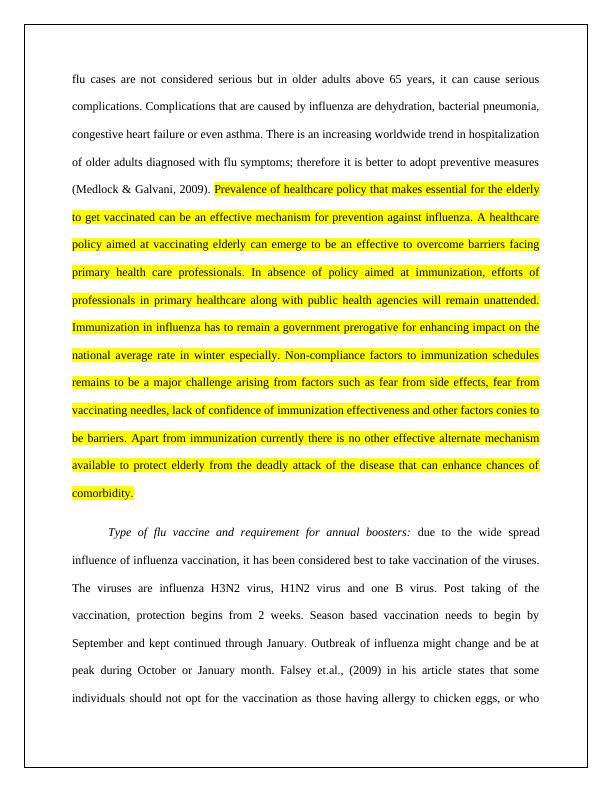Evaluation of Annual Influenza Vaccination for Older Adults and Community Nurses
Added on 2023-06-13
10 Pages2934 Words151 Views
Evaluation of annual influenza
vaccination being recommended for
individuals older that 65, and for those
who are regularly exposed to older
individuals such as community nurses
Student Name: Student ID:
Subject Name: Subject ID:
Date Due: Professor Name:
vaccination being recommended for
individuals older that 65, and for those
who are regularly exposed to older
individuals such as community nurses
Student Name: Student ID:
Subject Name: Subject ID:
Date Due: Professor Name:

Flu or influenza affects immunity system of older adults and young children easily. Due
to weak immunity response of older adults, infants, young children, they are more susceptible
from the attack to the virus. Older adults over 65 years of age receiving medical treatment at the
community hospital are at greater risks of getting infected from the disease. Community nurses
handle a wide variety of patients, facing multiple medical conditions; flu is the most common
type of virus that affects majority of patients receiving treatment at the community hospital.
Community nurses having to treat so many patients have risks of bearing the disease virus
themselves. Mc Elhaney (2011) in his paper explores that older adults face risks from getting
infected from the disease easily when in contact with older community nurses. The scope of this
analysis identifies recommendations that are given to adults over 65 years of age to get
vaccinated in case they are treated by older community nurses.
Flu: Influenza is commonly known as flu, is caused by a virus that causes respiratory
illness. The flu virus is highly contagious in nature that spreads through infected persons cough
or sneezes (Holland et. al., 2008). Flu is not a life threatening disease and adults are highly
contagious for 1 to 2 days prior to getting symptoms, which might continue till 7 days of
becoming ill. Symptoms associated with influenza are runny nose, high fever, muscle pain, sore
throat, coughing, headache and feeling tired. The symptoms might last over a week and can
include gastrointestinal symptoms as vomiting, diarrhea and nausea. The flu is usually treated by
antibiotics unless the flu symptoms have aggravated into another illness that is caused by
bacteria. During flu season from 71% to 85% of the older population above 65 years have
experienced death and 54% to 70% had to be admitted to hospitals due to flu. Influenza is a
serious issue for older adults hence they need to be vaccinated (Song, et. al., 2010). Worldwide
treatment for flu is antibiotics such as antivirals oseltamivir and zanamivir. Though majority of
to weak immunity response of older adults, infants, young children, they are more susceptible
from the attack to the virus. Older adults over 65 years of age receiving medical treatment at the
community hospital are at greater risks of getting infected from the disease. Community nurses
handle a wide variety of patients, facing multiple medical conditions; flu is the most common
type of virus that affects majority of patients receiving treatment at the community hospital.
Community nurses having to treat so many patients have risks of bearing the disease virus
themselves. Mc Elhaney (2011) in his paper explores that older adults face risks from getting
infected from the disease easily when in contact with older community nurses. The scope of this
analysis identifies recommendations that are given to adults over 65 years of age to get
vaccinated in case they are treated by older community nurses.
Flu: Influenza is commonly known as flu, is caused by a virus that causes respiratory
illness. The flu virus is highly contagious in nature that spreads through infected persons cough
or sneezes (Holland et. al., 2008). Flu is not a life threatening disease and adults are highly
contagious for 1 to 2 days prior to getting symptoms, which might continue till 7 days of
becoming ill. Symptoms associated with influenza are runny nose, high fever, muscle pain, sore
throat, coughing, headache and feeling tired. The symptoms might last over a week and can
include gastrointestinal symptoms as vomiting, diarrhea and nausea. The flu is usually treated by
antibiotics unless the flu symptoms have aggravated into another illness that is caused by
bacteria. During flu season from 71% to 85% of the older population above 65 years have
experienced death and 54% to 70% had to be admitted to hospitals due to flu. Influenza is a
serious issue for older adults hence they need to be vaccinated (Song, et. al., 2010). Worldwide
treatment for flu is antibiotics such as antivirals oseltamivir and zanamivir. Though majority of

flu cases are not considered serious but in older adults above 65 years, it can cause serious
complications. Complications that are caused by influenza are dehydration, bacterial pneumonia,
congestive heart failure or even asthma. There is an increasing worldwide trend in hospitalization
of older adults diagnosed with flu symptoms; therefore it is better to adopt preventive measures
(Medlock & Galvani, 2009). Prevalence of healthcare policy that makes essential for the elderly
to get vaccinated can be an effective mechanism for prevention against influenza. A healthcare
policy aimed at vaccinating elderly can emerge to be an effective to overcome barriers facing
primary health care professionals. In absence of policy aimed at immunization, efforts of
professionals in primary healthcare along with public health agencies will remain unattended.
Immunization in influenza has to remain a government prerogative for enhancing impact on the
national average rate in winter especially. Non-compliance factors to immunization schedules
remains to be a major challenge arising from factors such as fear from side effects, fear from
vaccinating needles, lack of confidence of immunization effectiveness and other factors conies to
be barriers. Apart from immunization currently there is no other effective alternate mechanism
available to protect elderly from the deadly attack of the disease that can enhance chances of
comorbidity.
Type of flu vaccine and requirement for annual boosters: due to the wide spread
influence of influenza vaccination, it has been considered best to take vaccination of the viruses.
The viruses are influenza H3N2 virus, H1N2 virus and one B virus. Post taking of the
vaccination, protection begins from 2 weeks. Season based vaccination needs to begin by
September and kept continued through January. Outbreak of influenza might change and be at
peak during October or January month. Falsey et.al., (2009) in his article states that some
individuals should not opt for the vaccination as those having allergy to chicken eggs, or who
complications. Complications that are caused by influenza are dehydration, bacterial pneumonia,
congestive heart failure or even asthma. There is an increasing worldwide trend in hospitalization
of older adults diagnosed with flu symptoms; therefore it is better to adopt preventive measures
(Medlock & Galvani, 2009). Prevalence of healthcare policy that makes essential for the elderly
to get vaccinated can be an effective mechanism for prevention against influenza. A healthcare
policy aimed at vaccinating elderly can emerge to be an effective to overcome barriers facing
primary health care professionals. In absence of policy aimed at immunization, efforts of
professionals in primary healthcare along with public health agencies will remain unattended.
Immunization in influenza has to remain a government prerogative for enhancing impact on the
national average rate in winter especially. Non-compliance factors to immunization schedules
remains to be a major challenge arising from factors such as fear from side effects, fear from
vaccinating needles, lack of confidence of immunization effectiveness and other factors conies to
be barriers. Apart from immunization currently there is no other effective alternate mechanism
available to protect elderly from the deadly attack of the disease that can enhance chances of
comorbidity.
Type of flu vaccine and requirement for annual boosters: due to the wide spread
influence of influenza vaccination, it has been considered best to take vaccination of the viruses.
The viruses are influenza H3N2 virus, H1N2 virus and one B virus. Post taking of the
vaccination, protection begins from 2 weeks. Season based vaccination needs to begin by
September and kept continued through January. Outbreak of influenza might change and be at
peak during October or January month. Falsey et.al., (2009) in his article states that some
individuals should not opt for the vaccination as those having allergy to chicken eggs, or who

End of preview
Want to access all the pages? Upload your documents or become a member.
Related Documents
Report on Influenza Infectionlg...
|3
|383
|70
Influenza: Prevention and treatmentlg...
|14
|3890
|28
Epidemiology: Influenzalg...
|12
|3013
|52
Assignment on Influenza Vaccinelg...
|7
|1494
|382
Study of Different Diseases: Vaccines, Durability, Side Effects, and Morelg...
|7
|1581
|99
Effective Nursing Essay 2022lg...
|11
|2459
|36
